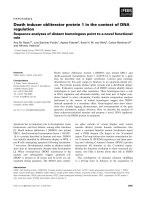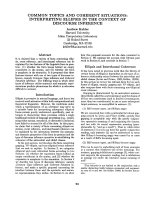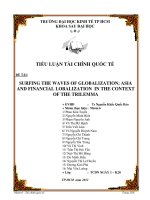Status of Kirati languages in the context of Nepalese languages
Bạn đang xem bản rút gọn của tài liệu. Xem và tải ngay bản đầy đủ của tài liệu tại đây (243.42 KB, 12 trang )
STATUS OF KIRATI LANGUAGES IN THE
CONTEXT OF NEPALESE LANGUAGES
Govinda Bahadur Tumbahang
ABSTRACT
This article highlights the linguistic scenario of multilingual
Nepal, and measures the vitality levels of overall languages in general
and Kirati languages in particular on the basis of Expanded Graded
Intergenerational Disruption Scale (EGIDS) used by Lewis and Simons
(2010) derived from Fishman's Graded Intergenerational Disruption
Scale (GIDS 1991). The first part presents the linguistic situation of
Nepal, the second part demonstrates the vitality levels of Nepalese
languages in general, the third part indicates the status of Kirati
languages and the last part provides some suggestions.
Key Words: Linguistic, multilingual, intergenerational, disruption,
vitality, moribund, extinct.
LINGUISTIC SITUATION OF NEPAL
CBS (2014) enumerated 123 languages. They have been classified
into Indo-European, Sino-Tibetan, Austro-Asiatic and Dravidian families of
languages. In addition, Kusunda is classified as "language isolate" which can
form a separate family. On the basis of the number of languages, SinoTibetan family is the largest, Indo-European family is the second largest,
Austro-Asiatic family is third largest and Dravidian is the smallest of the
families. Sino-Tibetan family comprises 63 languages. They are listed in
appendix 1. Indo-European family has 37 languages. They are listed in
appendix 2. Austro-Asiatic family consists of Khariya and Santhali, and
Dravidian family consists of Uranw/Urau language. Kusunda is the only
language, which does not belong to any of these families.
In terms of number of speakers, Indo-European family is the largest,
Sino-Tibetan family is the second largest, Austro-Asiatic family is the third
largest, Dravidian family is the fourth largest and Kusunda is the smallest of
all families of languages. The population of the speakers of Indo-European
languages totals 21,748,043, of Sino-Tibetan languages totals 4,583,718, of
Austo-Asiatic languages 50,096, of Dravidian language 33,651 and of
Kusunda language totals 28.
In addition to the four families and one language isolate, CBS
(2014) has listed 18 languages under "foreign/not classified" category.
They are Arabi, Assami, Chinese, Dzongkha, French, English, Gadhwali,
Hariyanwi, Kuki, Kurmali, Malpande, Mizo, Nagamese, Oriya, Russian,
Dr. Tumbahang is Professor Centre for Nepal and Asian Studies (CNAS), T.U., Kirtipur, Nepal
68
STATUS OF KIRATI LANGUAGES IN...
Sadhani, Sindhi and Spanish. Under "others/ not reported" category, it has
included sign language. Foreign/not classified category of languages have
5,601 speakers and others/not reported have 73,367 speakers.
Nepali, the only official language of Nepal, is dominant in every
domain of language use. It is spoken by 11,826,953 populations, which
constitutes 44.64 percent of the total population. In population census
2001 (CBS 2002), the present languages namely Achhami, Baitedeli,
Bajhangi, Bajureli, Dadeldhuri, Dailekhi, Darchuleli, Doteli, Jumli and
Khas were included in Nepali. These language-speakers constitute 1,293,
539 people. If this number were added to the population of Nepali
speakers, it would make up 13,120,492 populations. There are eight
languages of Indo-European family which have more than 1 percent of
speakers. They are given in Table 1.
Table 1: Indo-European Aryan Languages with More than 1 Percent of
Speakers
S.N.
1.
2.
3.
4.
5.
6.
7.
8.
Languages
Nepali
Maithili
Bhojpuri
Tharu
Bajjika
Doteli
Urdu
Baitadeli
Number of Speakers
11,826,953
3,092,530
1,584,958
1,529,875
793,416
787,827
691,546
272,524
Percent
44.64
11.67
5.98
5.77
2.99
2.97
2.61
1.03
Source: CBS, 2012.
Similarly, there are five languages of Sino-Tibetan family, which
have more than 1 percent of speakers. They are given in Table 2.
Table 2: Sino-Tibetan Languages with More than 1 percent of Speakers
S.N.
Languages
Number of Speakers
Percent
1,353,311
5.11
1.
Tamang
2.
Newar
846,557
3.2
3.
Magar
788,530
2.98
4.
Limbu
343,603
1.3
5.
Gurung
325,622
1.23
Source: CBS, 2012.
Dadeldhuri of Indo-European family, which was included in
Nepali in previous population censuses, is the only languages which have
less than 500 speakers. Khariya of Austro-Asiatic family and Kusunda,
the language isolate have less than 500 speakers. Table 3 presents SinoTibetan languages which have less than 500 speakers.
TRIBHUVAN UNIVERSITY JOURNAL, VOLUME. XXIX, NUMBER 1, JUNE 2016
69
Table 3: Sino-Tibetan Languages with Less than 500 of Speakers
S.N.
1.
2.
3.
4.
5.
6.
7.
8.
9.
10.
11.
Languages
Byangsi
Khamchi (Raute)
Sam
Manange
Phangduwali
Surel
Baram
Lingkhim
Kagate
Bankariya
Kaike
Number of Speakers
480
461
401
392
290
287
155
129
99
69
50
Source: CBS, 2012.
VITALITY LEVELS OF NEPALESE LANGUAGES IN GENERAL
It has not yet been clear how to identify the vitality level of a
language. However, sociolinguists and linguistic anthropologists seek to
measure language vitality levels on the basis of the number of speakers and
the use of the language in certain domains or functions. In addition, the
number of bilinguals and their proficiency levels are also considered while
measuring language vitality. Generally, speakers of small and less dominant
languages abandon their mother tongues in favour of dominant languages,
and use the second language with their children. In the course of time, the
intergenerational transmission of the heritage language stops and eventually
becomes useless with nobody speaking this language. This level of language
vitality is called dormant or extinct. Such language exists only in record, and
unrecorded languages without any speaker disappear.
Lewis and Simons (2010) adapted and expanded Fishman's
Graded Intergenerational Disruption Scale (GIDS, 1991) as Expanded
Graded Intergenerational Disruption Scale (EGIDS) to measure the
vitality of languages at different levels. It is presented in Table 4.
Table 4: Expanded Graded Intergenerational Disruption Scale
Level
0
Label
International
1
National
2
Provincial
3
Wider
communication
Description
The language is used internationally for a broad range
of functions.
The language is used in education, work, mass media,
and government at the nationwide level.
The language is used for local and regional mass
media and government services.
The language is used for local and regional work by
both insiders and outsiders.
70
STATUS OF KIRATI LANGUAGES IN...
4
Educational
5
Developing
6a
Vigorous
6b
Threatened
7
Shifting
8a
Moribund
8b
Nearly extinct
9
Dormant
10
Extinct
The language is being transmitted and standardization
promoted through a system of institutionally supported
education.
The language is used for face-to-face communication
by all generations and has effective educational
support in parts of the community
The language is used for face-to-face communication
by all generations and has effective educational
support in parts of the community.
The language is used for face-to-face communication
by all generations but only some of the children are
learning it.
The child-bearing generation knows the language well
enough to use it among themselves but it is not being
transmitted to their children,
The only remaining active users of the language are
members of the grandparent generation.
The only remaining users of the language are members
of grandparent generation or older who have little
opportunity to use the language.
The language serves as a reminder of heritage identity for
an ethnic community. No one has more than symbolic
proficiency.
No one retains a sense of ethnic identity associated
with the language, even for symbolic purposes.
Source: Ethnologue: Languages of Nepal, 2012.
Eppele et al. (2012) have measured vitality levels of languages of
different families of Nepal using EGIDS, and worked out the result as
described in the following subheadings:
INDO-EUROPEAN FAMILY
On the basis of EGIDS, Nepali has vitality level 1, and is labeled as
"national language". It is the language used in government offices, education
and mass media at the national level. There is no provincial language in Nepal
as of now. Hindi is used for wider communication in the Tarai region, but it is
not used in government services. It has vitality level 3, and is labeled as
"Wider communication". Avadhi, Bhojpuri, Urdu, Dotyali and Tharu Rana
are classified as level 4 languages, and labeled as "educational". Maithili,
Marwari, Rajbangsi and Tharu languages are classified as level 4 languages,
and labeled as "developing". Jumli, Kayort, Kisan and Humla Dangali are
classified as level 6a languages, and labeled as "vigorous". Angika, Bote,
Darai, Majhi and Musasa are classified as level 6b languages, and labeled as
"Threatened". Danuwar, Kumhali and Sonha are classified as level 7
languages, and labeled as "shifting". There are no 8a, 8b and 10 level
TRIBHUVAN UNIVERSITY JOURNAL, VOLUME. XXIX, NUMBER 1, JUNE 2016
71
languages which are labeled as "moribund", "nearly extinct" and "extinct".
Sanskrit is the only level 9 dormant language of this family.
SINO-TIBETAN FAMILY
There is not even a single language which is a level 1, national
language, nor is there any level 2 provincial, nor
level 3 wider
communication languages in this family. Tibetan is the only level 4,
educational language. Kham, Koi, Lhomi, Sherpa, Tamang, Wambule and
Thulung are level 5 developing languages. Bahing, Byangsi, Dhimal, Dolpo,
Ghale, Kagate, Kaike, Khaling and Tamang are classified as level 6a
languages and labeled as "vigorous". Athpariya, Bantawa, Belahare,
Chamling, Chhantyal, Chepang, Chhintang, Ghale, Jero/Jerung, Jirel, Kham,
Kulung,Limbu, Lohorung, Magar, Manange (Managwa), Meche, Mewahang,
Puma, Raji, Sampang, Sunuwar, Thangmi (Thami), Waling/Walung,
Wambule, Yakkha and Yamphu are level 6b languages and labeled as
"threatened". Bhujel, Chhulung/Chhiling, Dumi, Lapcha, Nacchiring,
Phangduwali, Thakali and Wayu/Hayu are level 7 languages, and labeled as
"shifting". Tilung is a level 8a language, and labeled as "moribund". Baram,
Lingkhim and Sam are level 8b languages, and they are labeled as "nearly
extinct". Dura is a level 9 language labeled as "dormant", and Waling/Walung
is a level 10 language labeled as "extinct".
Austro-Asiatic
Santhali is a level 6a language with the label vigorous. Khariya is
a level 6b language, and labeled as "threatened".
Dravidian
Uranw/Uraun also called Jhangad is a level 6b language with the
label "threatened".
Status of Kirati Languages
Kirati ethnic group includes Rai, Limbu, Yakkha and Sunuwar. The
Rai have their ethnic organization 'Kirat Rai Yayokkha,' the Limbu have
'Kirat Yakthung Chumlung' and the Yakkha have ethnic organization 'Kirat
Yakkha Chhumma.' The Sunuwar have ethnic organization 'Sunuwar Samaj'
without any mention of Kirat. However, they are regarded as Kirati as they
identify themselves with this ethnic name. Though ethnically, the Hayu are
not accepted as Kirati, their language is, nevertheless, included in the list of
Kirati languages (Wiedert and Subba, 1985; Ebert, 1994). There are many
ethnic branches under the Rai subgroup, and each branch has a separate
language. The languages have dialects, and some linguists classify the
dialects as different languages. In addition, since 2011 population census, the
trend to separate from the Rai ethnic subgroup and establish their independent
ethnic and linguistic identity has become common among those who
previously identified themselves as Rai. It has created a serious problem in
72
STATUS OF KIRATI LANGUAGES IN...
identifying the exact number of Rai ethnic subgroup and their languages. The
following subheadings highlight the scenario of Kirati languages:
No Clear Link between Ethnicity and Language
CBS (2002) reported 22 different languages under the ethnic
name Rai. They were Bahing, Bantawa, Chamling, Chhiling, Chhintang,
Dumi, Dungmali, Jero/Jerong, Khaling, Koyu/Koyee, Kulung, Lingkhim,
Lohorung, Mewahang, Nacchiring, Puma, Sam, Sampang, Thulung,
Tilung, Wambule and Yamphu . These languages were added to Limbu,
Yakkha, Sunuwar and Hayu, and given the umbrella term "Kirati
languages". Population Census (2011) recorded separate ethnic status of
Bahing, Bantawa, Chamling, Khaling, Kulung, Lohorung, Mewahang
Bala, Nacchiring, Sampang, Thulung, Walung and Yamphu, and CBS
(2012) established their independent language names similar to the ethnic
names. The census also recorded Rai as an independent ethnic name and
CBS (2012) established Rai as a separate language name. However, the
ethnic names of Chhiling, Chhintang, Dumi, Dungmali, Jero/Jerong,
Lingkhim, Mewahang, Sam, Tilung and Wambule language-speakers
were not recorded. So, questions such as whether they are still Rai or not,
and whether their population was included in the Rai subgroup or not are
difficult to answer. On the other hand, Athpariya and Belahare have been
recorded in this census. Athpariya, previously known by the ethnic name
Rai abandoned it and has assumed Athpariya itself as its ethnic name. The
ethnicity of Belahare speakers, though not mentioned in the census report,
their ethnic name is Athpariya as they call themselves by this ethnic name.
The population of traditional Rai ethnic group and their languages are
distributed in Table 5.
Table 5: Population Distribution of Traditional Rai Ethnic Groups and
their Languages
S.N.
1.
2.
3.
4.
5.
6.
7.
8.
9.
10
11.
12
13.
14.
Ethnic name
Athpahariya
Bahing
Bantawa
Population
5,977
3,096
4,604
Chamling
6,668
Khaling
1,571
Kulung
28,613
Language Name
Athpariya
Bahing
Bantawa
Belahare
Chamling
Chhilling
Chhintang
Dumi
Dungmali
Jero
Khaling
Koyee
Kulung
Limkhim
Population
5,530
11,658
132,583
599
76,800
2,046
3,712
7,638
6,260
1763
14,467
1,271
33,170
129
73
TRIBHUVAN UNIVERSITY JOURNAL, VOLUME. XXIX, NUMBER 1, JUNE 2016
15.
16.
17.
18.
19.
20.
21.
22.
23.
24.
25
26.
27.
Lohorung
Mewahang Bala
Nacchiring
Rai
1,153
3,100
7,154
620,004
Sampang
Thulung
1,681
3,535
Waling
1,249
Yamphu
6,933
Lohorung
Mewahang
Nacchiring
Phangduwali
Puma
Rai
Sam
Sangpang
Thulung
Tilung
Waling
Wambule
Yamphu
3,716
4,650
10,041
290
6,686
159,114
401
18,270
20,659
1,424
1,169
13,470
9,208
Source: CBS, 2012.
The Kirati languages, which have clear link with ethnicity, are
only Hayu, Limbu, Sunuwar and Yakkha. Hayu is not regarded as a
member of the Kirati ethnic group, but the language spoken by them is
considered as a Kirati language. The ethnic and language population of
these ethnic subgroups are given in Table 6.
Table 6: Population of Hayu, Limbu, Sunuwar and Yakkha and of their
Languages
S.N. Ethnic Name
Population
Language Name Population
1.
Hayu
2925
Hayu
1,520
2.
Limbu
387,300
Limbu
343,603
3.
Sunuwar
95,245
Sunuwar
26,611
4.
Yakkha
17,003
Yakkha
19,558
Source: CBS, 2012.
No Exact Number of Kirati Languages
Grierson (1909) records 13 languages of Kirati Rai group.
Wiedert and Subba (1985) record 20 languages of Kirati group. They are
Sunuwar, Hayu, Ombule/Jerung, Thulung, Khaling, Kulung, Dumi, Koi,
Chamling, Puma, Bantawa, Dungmali, Chhintange, Sampang, Mewahang,
Lohorung, Yamphe/Yamphu, Yakkha, Athpariya and Limbu. Hanson
(1991) classifies Kirati group of languages into western, central and
eastern Kirati languages. Eastern Kirati languages include Limbu,
Chhatthare Limbu, Athpare, Belahare, Chhulung, Chhintang, Baiyangsi,
Chongkha, Lungoba, Mugali, Phangduwali, Lumba-Yakkha, Yakkha,
Southern Lohorung, Yamphu, Yamphe and Northern Lohorung. Central
Kirati language group includes Bantawa, Puma, Chamling, eastern
Mewahang, western Mewahang, Sambya, Pongyong, Bungla, Chukwa,
Sampang, Kulung, Nacchiring, Dungmali, Waling and Khandung.
Western Kirati languages include Ombule, Jero, Thulung, Lingkhim,
74
STATUS OF KIRATI LANGUAGES IN...
Bahing, Sunuwar, Khaling, Dumi, Koi, Hayu, Tilung, Choskule and
Dorungkecha. He identifies altogether 45 Kirati languages. As a matter of
fact, Hanson's report is based on the Linguistic Survey of Nepal conducted
jointly by University of Kiel, Germany and Tribhuvan University, Nepal
in 1981-84 in Mechi, Koshi and Sagarmatha zones of Nepal. Ebert (1994)
lists 21 languages under Kirati group. They are Hayu, Sunuwar, Bahing,
Chaurase, Thulung, Khaling, Kulung, Dumi, Sampang, Chamling, Puma,
Bantawa, Dungmali, Mewahang, Yamphe, Lohorung, Yakkha, Chhintang,
Belahare, Athpare and Limbu. Khambu (2000) includes Jerung, Wambule,
Tilung, Chamling, Puma, Khaling, Thulung, Kulung, Bahing,Nacchiring,
Sotang, Koyu, Dumi, Sampang, Yamphu, Lohorung, Bungla, Bantawa,
Dungmali, Mugali, Phangduwali, Chhintange, Chhilinge, Mewahang,
Athpare and Belahare. Van Driem (2001) lists 25 languages as Kirati
languages. They are Mewahang, Lohorung, Yamphe, Yakkha, Chhiling,
Athpare, Limbu, Kulung, Sampang, Nacchiring, Chamling, Puma,
Bantawa, Dungmali, Chhintang, Dumi, Koi, Khaling, Thulung, Tilung,
Wambule, Jero, Bahing, Hayu and Sunuwar.
Population Census (2001) also reports 25 Kirati languages. CBS
(2012) records 31 Kirati languages, whereas Eppille et al. (2012) record
35 languages considering Lumba-Yakkha, Mewahang (western), Yamphu
(southern) and Mugali as different languages. The above reports prove
that the exact number of Kirati languages is yet uncertain.
Vitality Levels of Kirati Languages
Languages of Kirati group have not been used in education, work,
mass media and government at the nationwide level. They have not been used
for local and regional mass media and government services. They have not
been used for local and regional work by insiders and outsiders, nor have they
been transmitted, and their standardization been promoted through a system
of institutionally supported education. If the vitality level of the languages of
Kirati group were measured according to EGIDS, there would be no level 1, 2
, 3 and 4 languages which could be labeled "national", "provincial", "wider
communication" and "educational". Koi, Wambule and Thulung are level 5
languages with the label "developing". Bahing and Khaling are level 6a
languages with the label "vigorous".
Athpariya, Bantawa, Belahariya, Chamling, Chhintang,
Dungmali, Jerung/Jero, Kulung, Limbu, Lohorung, Mewahang , Puma,
Sampang, Sunuwar, Yakkha and Yamphu are 6b level languages labeled
as "threatened". Chhulung, Dumi, Nacchiring, Phangduwali and
Wayu/hayu are level 7 languages labeled as "shifting". Tilung and
Chukwa are level 8a languages labeled as "moribund". Lingkhim and Sam
are level 8b languages labeled as "nearly extinct". Waling is a level 10
language labeled as "extinct".
TRIBHUVAN UNIVERSITY JOURNAL, VOLUME. XXIX, NUMBER 1, JUNE 2016
75
SUMMARY
Three languages are at vitality level 3 and only 2 languages are at
vitality level 6a. Sixteen languages have vitality level 6b and 5 languages
have vitality level 7, 2 languages have vitality level 8a, 2 languages have
vitality level 8b and 1 language has vitality level 10. Out of 31 Kirati
languages recorded in CBS (2012) only 5 languages, namely, Koi,
Wambule, Thulung, Bahing and Khaling have vitality to survive. Rest of
the Kirati languages are below 6b level and are following downward
endangerment trend such as threatening, shifting, moribund, nearly extinct
and extinct.
SUGGESTIONS
Linguistic Survey conducted in the Kosi, Mechi and Sagarmatha
zones jointly by University of Kiel, Germany and Tribhuvan
University, Nepal in the first half of the 1980s have not been
followed up so far. The report prepared by Hanson (1991) on the
basis of the field linguistic survey has been ignored and the
number of Kirati languages has been recorded in different
censuses (2001, 2011) on the basis of the report of the informants.
Therefore, there is no fixed number of Kirati languages. If
sociolinguistic survey is carried out systematically, the exact
number of Kirati languages can be ascertained.
Vitality of a language can be increased by raising the number of
the speakers of that language through intergenerational
transmission and expanding the domains of the use of that
language. To achieve this goal, government mother tongue
education schools should be run.
Unwritten languages should be documented and their scripts and
orthographies should be developed.
Multilingual dictionary, descriptive grammar, reference and
pedagogical grammars should be published.
These languages should have access to F.M., radio and TV to air
different programmes.
Autonomous national language academy should be established.
Suggestions submitted by National Language Policy and
Recommendation Commission (2050 B.S.) should be
implemented.
76
STATUS OF KIRATI LANGUAGES IN...
ANNEXES
ANNEX-1
Sino-Tibetan Languages
S.
N.
Language
S.
N.
Language
S.
N.
Language
S.
N.
Language
1.
Athpariya
17.
Dungmali
33.
Lhomi
49.
Sam
2.
Bahing
18.
Dura
34.
Lhopa
50.
Sampang
3.
Bankariya
19.
Ghale
35.
Limbu
51.
Sherpa
4.
Bantawa
20.
Gurung
36.
Lingkhim
52.
Sunuwar
5.
Baram
21.
Hayu/Vayu
37.
Lohorung
53.
Surel
6.
Belahare
22.
Hyolmo/Yholmo
38.
Magar
54.
Tamang
7.
Bhujel
23.
Jero/Jerung
39.
Manange
55.
Thakali
8.
Byangsi
24.
Jirel
40.
Meche
56.
Thami
9.
Chamling
25.
Kagate
41.
Mewahang
57.
Thulung
10.
Chepang
26.
Kaike
42.
Nacchering
58.
Tibetan
11.
Chhantyal
27.
Khaling
43.
Newar
59.
Tilung
12.
Chhiling
28.
Kham
44.
Pahari
60.
Waling/
Walung
13.
Chhintang
29.
Khamchi (Raute)
45.
Phangduwali
61.
Wambule
14.
Dhimal
30.
Koyee
46.
Puma
62.
Yakkha
15.
Dolpali
31.
Kulung
47.
Rai
63.
Yamphu/
Yamphe
16.
Dumi
32.
Lapcha
48.
Raji
77
TRIBHUVAN UNIVERSITY JOURNAL, VOLUME. XXIX, NUMBER 1, JUNE 2016
ANNEX-2
Indo-European languages
S.N.
Language
S.N.
Language
S.N.
Language
1.
Acchami
14.
Darai
27.
Majhi
2.
Angika
15.
Darchuleli
28.
Musalman
3.
Avadhi
16.
Dhuleli
29.
Nepali
4.
Baitadeli
17.
Doteli
30.
Panjabi
5.
Bajhangi
18.
Gangai
31.
Rajbangsi
6.
Bajjika
19.
Hindi
32.
Rajasthani
7.
Bajureli
20.
Jumli
33.
Sanskrit
8.
Bangla
21.
Khas
34.
Sonaha
9.
Bhojpuri
22.
Kisan
35.
Tajpuriya
10.
Bote
23.
Koce
36.
Tharu
11.
Dadeldhuri
24.
Kumal
37.
Urdu
12.
Dailekhi
25.
Magahi
13
Danuwar
26.
Maithili
78
STATUS OF KIRATI LANGUAGES IN...
WORKS CITED
CBS (2002). National Population Census 2001. Kathmandu: Central
Bureau of Statistics (CBS), Government of Nepal.
--- (2012). National Population and Housing Census 2011: National
Report. Kathmandu: Central Bureau of Statistics (CBS),
Government of Nepal.
Ebert, Karen H. (1994). The Structure of Kiranti Languages. Zurich:
ASAS- Verlag.
Eppele, M. John, Pual Lewis, Dan Raj Regmi, and Yogendra P. Yadava
(eds.). (2012). Ethnologue: Languages of Nepal. Kathmandu:
Central Department of Linguistic and SIL International.
Fishman, J.A. (1991). Reversing Language Shift. Clevedon: Multilingual
Matters.
Hanson, Gerd (1991). The Rai of Eastern Nepal: Ethnic and Linguistic
Grouping. Kathmandu: Tribhuvan University.
Konow, S. (1909). Tibeto-Burman Family. Linguistic Survey of India.
Vol. 111, ed. by Grierson, G.A. Calcutta: Superintendent of
Government Printing, India.
Lewis, M.P. and Simons, G.F. (2010). "Assessing endangerment:
Expanding Fishman's GIDS." Reviue Romaine de Linguistique.
55.103-120.
Van Driem, George. (2001). Languages of the Himalayas Volume 2.
Leiden: Brill.
Weidert, Alfons and Bikram Subba (1985). Concise Limbu Grammar and
Dictionary. Amsterdam: Lobster Publications.
vDa", cf/=s]= -lj=;+= @)%&_= t'ngfTds zAb ;ª\u|x= sf7df8f}+M ls/ft /fO{ efiff
tyf ;flxTo kl/ifb\ .









